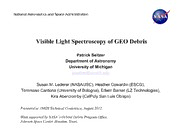
NASA Technical Reports Server (NTRS) 20120006134: Visible Light Spectroscopy of GEO Debris PDF
Preview NASA Technical Reports Server (NTRS) 20120006134: Visible Light Spectroscopy of GEO Debris
Abstract for AMOS Technical Conference, 11-14 Sept 2012 www.amostech.com Visible Light Spectroscopy of GEO Debris1,2 Patrick Seitzer Department of Astronomy University of Michigan Susan M. Lederer NASA/JSC Heather Cowardin ESCG/Jacobs Edwin S. Barker LZ Technology, Inc. Kira J. Abercromby Aerospace Engineering Department California Polytechnic State University San Luis Obispo Our goal is to understand the physical characteristics of debris at geosynchronous orbit (GEO). Our approach is to compare the observed reflectance as a function of wavelength with laboratory measurements of typical spacecraft surfaces to understand what the materials are likely to be. Because debris could be irregular in shape and tumbling at an unknown rate, rapid simultaneous measurements over a range of wavelengths are required. Acquiring spectra of optically faint objects with short exposure times to minimize these effects requires a large telescope. We describe optical spectroscopy obtained during 12-14 March 2012 with the IMACS imaging spectrograph on the 6.5-m 'Walter Baade' Magellan telescope at Las Campanas Observatory in Chile. When used in f/2 imaging mode for acquisition, this instrument has a field of view of 30 arc-minutes in diameter. After acquisition and centering of a GEO object, a 2.5 arc-second wide slit and a grism are moved into the beam for spectroscopy. We used a 200 l/mm grism blazed at 660 nm for wavelength coverage in the 500-900 nm region. Typical exposure times for spectra were 15-30 seconds. Spectra were obtained for five objects in the GEO regime listed as debris in the US Space Command public catalog, and one high area to mass ratio GEO object. In addition spectra were obtained of three cataloged IDCSP (Initial Defense Communications Satellite Program) satellites with known initial properties just below the GEO regime. All spectra were calibrated using white dwarf flux standards and solar analog stars. We will describe our experiences using Magellan, a telescope never used previously for orbital debris spectroscopy, and our initial results. 1. This work is supported by NASA’s Orbital Debris Program Office, Johnson Space Center, Houston, Texas, USA. 2. This paper includes data gathered with the 6.5 meter Magellan Telescopes located at Las Campanas Observatory, Chile. National Aeronautics and Space Administration Visible Light Spectroscopy of GEO Debris Patrick Seitzer Department of Astronomy University of Michigan [email protected] Susan M. Lederer (NASA/JSC), Heather Cowardin (ESCG), Tommaso Cardona (University of Bologna), Edwin Barker (LZ Technologies), Kira Abercromby (CalPoly San Luis Obispo) Presented at AMOS Technical Conference, August 2012. Work supported by NASA’s Orbital Debris Program Office, Johnson Space Center, Houston, Texas. National Aeronautics and Space Administration Spectroscopy • Goal – visible light (4000 – 8000 Angstrom) spectroscopy of GEO debris for comparison with laboratory spectra of actual spacecraft materials. • What are the possible surfaces seen at GEO? • Simultaneous wavelength coverage. • Using imaging spectrographs on Magellan 6.5-m telescopes. Large telescopes in excellent seeing – short exposure times. Important if irregularly shaped object tumbling. 2 National Aeronautics and Space Administration 6.5-m Magellan Telescopes Las Campanas Observatory, Chile Baade – imaging & spectroscopy Clay - spectroscopy Collaboration of Carnegie Institution, University of Arizona, Harvard University, University of Michigan, and Massachusetts Institute of Technology. 3 National Aeronautics and Space Administration Spectroscopy at Magellan • March 2012 – first attempts with Baade telescope. – IMACS – Inamori Magellan Areal Camera and Spectrograph. – 30 arc-minute diameter field of view for acquisition. – 3 nights. – Spectra acquired of 6 GEO debris pieces (1 high area to mass) and 3 IDCSP satellites. – Reductions in progress. • May 2012 – Clay telescope. – LDSS3: Low Dispersion Survey Spectrograph (Version 3) designed for cosmology. – 8.3 arc-minute diameter acquisition field of view. – 5 arc-second wide slit. – Two half nights. – Spectra of 5 cataloged GEO debris pieces plus 1 IDCSP object. – Exposure time 30 seconds/spectra. – Preliminary results from one half-night reported here. 4 National Aeronautics and Space Administration LDSS3 on Clay Telescope • Sampling – 2 Angstroms/pixel. Smoothed spectrum yield 10 A resolution. • 30 second exposures. • Spectra divided by spectra of solar analog star (SF1615 – James Webb Space Telescope (JWST) standard). • Normalized to 1 in 7500-8000 Angstrom region. • Primary technical challenge – blind non-sidereal tracking to keep object in 5 arc-second wide slit. 5 National Aeronautics and Space Administration Targets • GEO or near GEO objects with recent TLEs selected from public catalog. • Objects visible from Chile during May 2012 run: SSN Launch Year Description 02655 1967 IDCSP 12996 1977 EKRAN 2 DEB LES 8,9/SOL 11A,B 13753 1976 DEB TITAN TRANSTAGE 25000 1968 DEB 29014 1977 EKRAN 2 DEB MSG 2 DEB 29106 2005 (COOLER COVER) 6 National Aeronautics and Space Administration Two objects of known launch characteristics 02655 IDCSP 15 1967-003H 29106 MSG 2 Cooler cover 2005-049E USAF Initial Defense Communications Satellite Program 1.9 meter^2 area 26 sided polygons of solar cells, 86 cm diameter Source: Jah and Kelecy IAC 2010 7 National Aeronautics and Space Administration Summary of Observations 8
